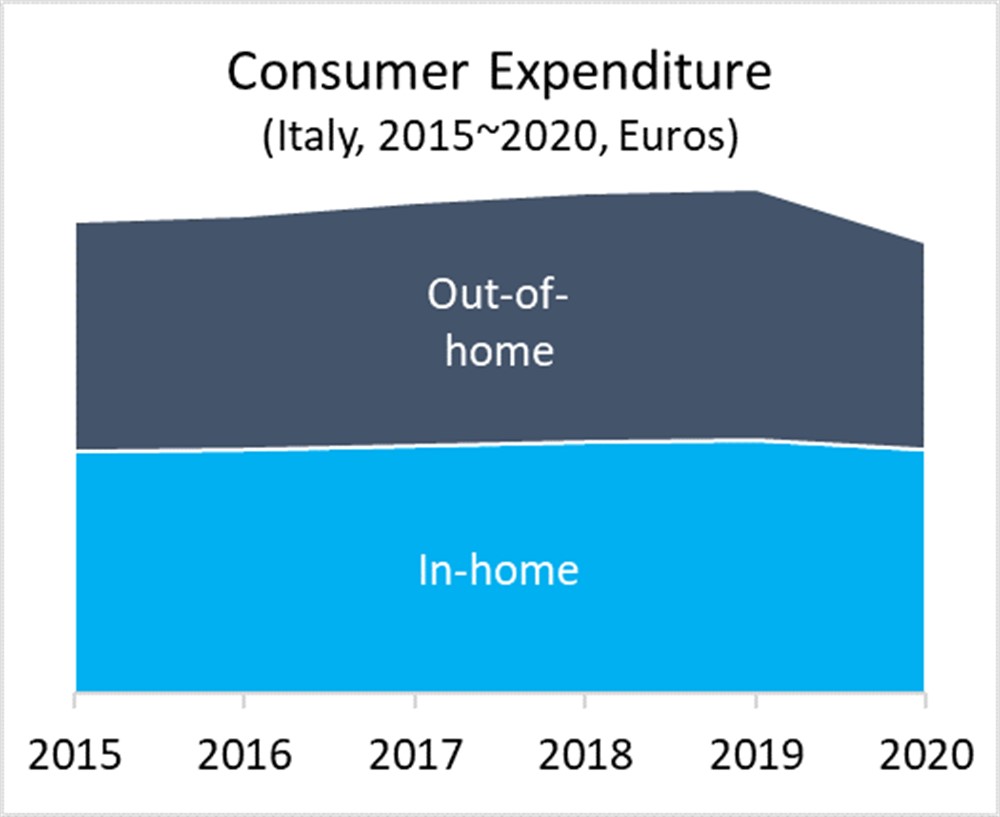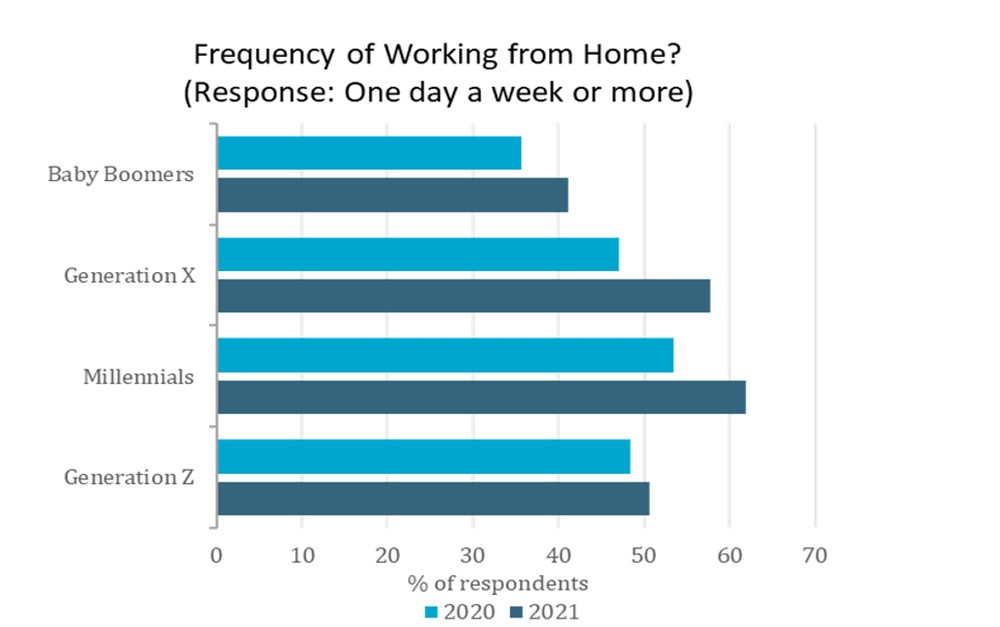
07/01/2022
Home Improvement and Gardening: Industry Trends and Looking Ahead
Source: Unsplash
Authors: Nick Stene, Miles Agbanrin and Sara Rovai
Extreme forces for growth met and overwhelmed the 2020 disruption
Suffering some of the worst forms of disruption in the early stages of the COVID-19 pandemic, consumer expenditure patterns in Italy were among the worst hit in Europe. Out-of-home expenditure fell in 2020 across the world, driven by closed hospitality, constrained socialising, and leisure options plus all the restrictions on travel. That decline was 9% globally and 18% in Italy - this part of the picture was in keeping with developed economies and especially other nations in Western Europe.
What stands out as unusual for Italy was what happened to in-home spending. Items such as food and drink, tobacco and alcohol and household goods on both global and European levels grew 2-4%, with clear links for out-of-home spending on hospitality and restaurants moving to become in-home consumption instead. Italy went against that pattern, with in-home spending also declining by 4%; in Western Europe, this was a trend shared only with Spain. Amid that harsh backdrop, there were some islands of optimism, with exceptions to the decline found in paint (up 15%), and barbeques (up 11%), and growth seen in tools and almost all aspects of gardening (up 4%) as discretionary spending moved from other priorities towards improving the home.

Source: Euromonitor International
The macroeconomic situation has since rebounded, and 2021 numbers look positive, from Italy’s GDP forecast up 6% after a successful vaccine roll-out, and with new-build houses and renovations back to strong growth (according to ANCE). Within this improved situation, home improvement and gardening are also helped along (beyond common factors shared across Europe) by the Italian government’s “Superbonus” stimulus programme.
The Superbonus went active from July 2020, with reimbursement schemes aimed at minimising expenditure for final customers and linking this to tax. The programme supports upgrading Italy’s legacy housing stock which mostly pre-dates any energy-saving technologies or legislation, funding up to 110% of the conversion costs for homes upgraded to modern eco-friendly standards with a cap of EUR100,000, supporting solar panels, heat pumps and other energy-efficient systems, insulation, air conditioning systems, structural reinforcement of homes, and even new doors and windows. In short, the Superbonus funds a list of installations that will impact ceilings, walls, and floors, driving first a need for renovation and secondly a need for redecoration. The scheme organisers report that starting from a depressed market, residential building renovations jumped 500% once the Superbonus was introduced. The Superbonus was originally intended to stop at the end of 2021, but it has been extended in a reduced form and is projected to be a weaker demand driver all the way through to the end of 2023.

Source: Pinterest
This stimulus is only part of the demand driver pushing growth in home improvement and gardening. Homeowners are exhibiting a greater focus on in-home comfort and wellbeing, investing in upgrading their living space. Looking at propensity data from Houzz for 2021, 43% of all homeowners in Italy planned to redecorate in 2021, and 32% were planning larger renovations (which is the largest activity level for that seen in more than four years). Kitchen refurbishments are proving extremely popular, particularly around increasing storage space and airflow, and in the garden the most popular changes have been installing more flower beds, building (and treating) fences and space dividers, and positioning various formats of plant pot (both inside the home and as outdoor decorations). Initial indications are that gardening sales in Italy have been growing more strongly than home improvement in 2021 - a pattern that matches data from other parts of Europe too.
The home-as-a-priority demand driver has a known horizon, as it is in part funded by (and inflated by) the lack of ability to spend on out-of-home factors such as flights, holidays, hospitality and leisure. When out-of-home spending normalises, this will stop driving home improvement and gardening demand; and we are seeing evidence of that in many countries in the latter part of 2021 but expect to see the full rebalancing of priorities in 2022 (the Omicron variant being a wild card for this in early December 2021).
Sustained hybrid-working is a long-term small boost to home and garden demand
The decade leading up to 2020 saw steady but gradual growth in the number of workers spending at least some of their week working from home. This was enabled by advances in videoconferencing and cloud computing and led by demand for flexible working policies from functions such as finance, law, technology support and professional services. Conditions imposed by the pandemic markedly accelerated this trend, initially with closed facilities, but leading to a fundamental change in the willingness of workers to come to offices, and a change in the efficiency and cost of workspaces due to social distancing. Data from Euromonitor’s Consumer Lifestyles survey show a notable rise in the proportion of respondents working at least one day from home between 2020 and 2021, with the largest increases coming from the Generation X and Millennial cohorts. This is a trend in global data and not just in Italy.

Source: Euromonitor International
Working from home is clearly an enduring feature of the labour market. Industry experts suggest that over half of polled workers in the US and the UK intend to continue to work from home for at least half of their week. In Italy, research by the Politecnico di Milano in 2021 showed that 81% of large companies and 51% of SMEs expected to maintain smart working policies in the future. Google mobility data in the final quarter of 2021 suggest that commuting and footfall in workplaces remain subdued in Italy (down 10-20% across regions), especially in cities.
Acting against this are efforts by those with a material interest in drawing consumers back into urban centres and, more importantly, bringing their spending back into shops, offices and restaurants. Many business owners have also been keener to see employees back in offices than those employees were keen to be there. A major labour shortage has created an employees’ market, matching a sharp rise in how much importance job seekers place on work-from-home policies and health and hygiene policies when judging potential employers, a factor seen in Euromonitor’s Lifestyles survey data for 2021, and forcing multiple large employers to visibly soften their stance on returning to offices.
In 2020 and through 2021, newly home-bound workers initially scrambled to convert living spaces into home offices; home seclusion during the pandemic contributed to a distinct spike in sales growth across the home and garden industry. One of the first products to benefit from this trend was, unsurprisingly, home office furniture. The category had seen steady historic growth at a 2% CAGR between 2014 and 2019. However, global retail sales expanded by USD1,817 million in 2020, surging by 9%. Much of this early spending was driven by necessity, with consumers picking up whatever furniture was available to fulfil immediate functional needs and fitting it wherever it would go in the home, with less consideration given to aesthetics. Longer term, this has manifested with built-in offices appearing in many different locations in the home, with Pinterest and other sites seeing an explosion in ideas and solutions, and multi-function products emerging to fit offices into bedrooms, kitchens, cupboards and closets. This also drove a great need for more integrated storage and space flexibility solutions, and the increase in home occupancy was also felt in products such as flooring, where noise insulation rose in importance when adults and children all need to live (and work) inside the four walls.

Source: Unsplash
Working from home has been the start point for many shopping journeys across the category, and this is lasting beyond initial desk investments, redecorations and disruptions over living space. An increased duration spent in proximity to the home and garden creates greater dissatisfaction with form and function, with new priorities bringing previously unfelt or ignored flaws into stark focus - this is another factor visibly adding to the background increase in demand for renovation and decoration products and services, not just in Italy but across Europe and the US. Given the resistance to back-to-the-office policy and the new rise in hybrid policy adoption, this is a smaller demand driver that is expected to boost home and garden industry sales for the foreseeable future.
Source: Euromonitor International